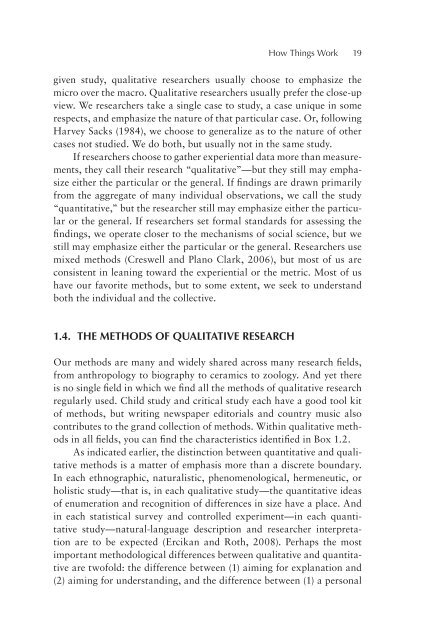How Things Work - Doha Academy of Tertiary Studies
How Things Work - Doha Academy of Tertiary Studies
How Things Work - Doha Academy of Tertiary Studies
You also want an ePaper? Increase the reach of your titles
YUMPU automatically turns print PDFs into web optimized ePapers that Google loves.
<strong>How</strong> things <strong>Work</strong> 19<br />
given study, qualitative researchers usually choose to emphasize the<br />
micro over the macro. Qualitative researchers usually prefer the close-up<br />
view. We researchers take a single case to study, a case unique in some<br />
respects, and emphasize the nature <strong>of</strong> that particular case. Or, following<br />
Harvey Sacks (1984), we choose to generalize as to the nature <strong>of</strong> other<br />
cases not studied. We do both, but usually not in the same study.<br />
If researchers choose to gather experiential data more than measurements,<br />
they call their research “qualitative”—but they still may emphasize<br />
either the particular or the general. If findings are drawn primarily<br />
from the aggregate <strong>of</strong> many individual observations, we call the study<br />
“quantitative,” but the researcher still may emphasize either the particular<br />
or the general. If researchers set formal standards for assessing the<br />
findings, we operate closer to the mechanisms <strong>of</strong> social science, but we<br />
still may emphasize either the particular or the general. Researchers use<br />
mixed methods (Creswell and Plano Clark, 2006), but most <strong>of</strong> us are<br />
consistent in leaning toward the experiential or the metric. Most <strong>of</strong> us<br />
have our favorite methods, but to some extent, we seek to understand<br />
both the individual and the collective.<br />
1.4. the MethODs OF Qualitative ReseaRch<br />
Our methods are many and widely shared across many research fields,<br />
from anthropology to biography to ceramics to zoology. And yet there<br />
is no single field in which we find all the methods <strong>of</strong> qualitative research<br />
regularly used. Child study and critical study each have a good tool kit<br />
<strong>of</strong> methods, but writing newspaper editorials and country music also<br />
contributes to the grand collection <strong>of</strong> methods. Within qualitative methods<br />
in all fields, you can find the characteristics identified in Box 1.2.<br />
As indicated earlier, the distinction between quantitative and qualitative<br />
methods is a matter <strong>of</strong> emphasis more than a discrete boundary.<br />
In each ethnographic, naturalistic, phenomenological, hermeneutic, or<br />
holistic study—that is, in each qualitative study—the quantitative ideas<br />
<strong>of</strong> enumeration and recognition <strong>of</strong> differences in size have a place. And<br />
in each statistical survey and controlled experiment—in each quantitative<br />
study— natural- language description and researcher interpretation<br />
are to be expected (Ercikan and Roth, 2008). Perhaps the most<br />
important methodological differences between qualitative and quantitative<br />
are tw<strong>of</strong>old: the difference between (1) aiming for explanation and<br />
(2) aiming for understanding, and the difference between (1) a personal

















